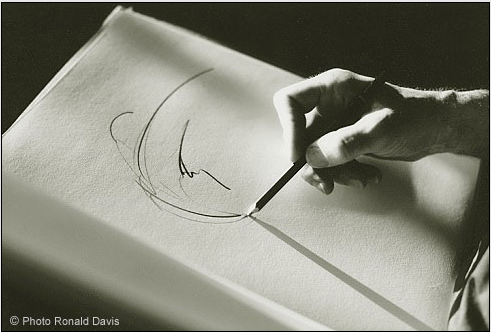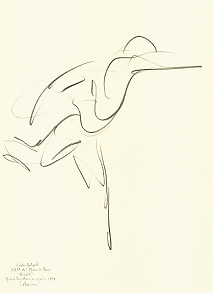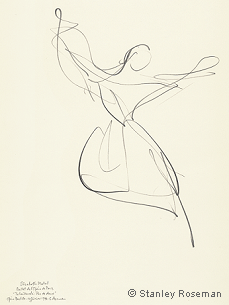
STANLEY ROSEMAN
Drawings
Drawings
*"Line is the essence of a drawing,'' is quoted from Roseman's text entitled "On Drawing and the Dance'' published in the fine art book Stanley Roseman and the Dance - Drawings from the Paris Opéra, (Paris, 1996).
"Line is the essence of a drawing."*
Photograph of the hand of the artist at work, Paris Opéra, 1994.
In his text "On Drawing and the Dance,'' Roseman concludes his discourse on the use of the graphite pencil:

The prestigious invitation to Roseman in 1989 from the Paris Opéra Administration was greatly meaningful as Dance holds a preeminent place in the cultural tradition of France and is an important subject in French art.
''Pencil is a drawing instrument by which I could explore an extensive range to the quality of the line not only to express the human form in changing patterns of dance movements but also to carry and transmit in a graphic medium the kinetic energy of the dancer.''[3]

2. Kader Belarbi, 1993, Paris Opéra Ballet
Giselle
Pencil on paper, 38 x 28 cm
Bibliothèque Nationale de France, Paris
Giselle
Pencil on paper, 38 x 28 cm
Bibliothèque Nationale de France, Paris
In his absorbing text, which precedes the plates in the book, Roseman writes about his thoughts on art and his passion for drawing. Drawings account for a great part of Roseman's oeuvre, as evident in the artist's concentration on certain themes and subject matter as with the dance and the performing arts in general; portraits and nudes; a series on cats, which began with pen and ink drawings of his feline friend from his youth; landscapes drawn en plein air in the four seasons; and a work on the monastic life comprising the four monastic orders of the Western Church and including "an extensive oeuvre of chalk drawings profoundly expressive of the individual and the interior life''[2] (Bibliothèque Nationale de France).
''You have presented the Cabinet of Prints and Drawings of the Museums of Strasbourg with an ensemble of five drawings of great quality by Stanley Roseman. . . . These remarkable portrayals of dancers of the Paris Opéra Ballet and of an actress drawn at the Ranelagh Theatre integrate quite naturally in the suite of our prestigious series of works by Bakst and Rodin and enrich in a wonderful way the collection of the Cabinet of Prints and Drawings."
- Rodolphe Rapetti
Curator of Patrimony
Director
Museums of Strasbourg
Curator of Patrimony
Director
Museums of Strasbourg
- Anny-Claire Haus
Curator
Cabinet of Prints and Drawings
Museums of Strasbourg
Curator
Cabinet of Prints and Drawings
Museums of Strasbourg
"Stanley Roseman's drawings show the many facets of his great talents as a draughtsman."[4]
- Bibliothèque Nationale de France, Paris
- Carel van Tuyll
Keeper of Prints and Drawings
Teylers Museum, Haarlem
Keeper of Prints and Drawings
Teylers Museum, Haarlem
Although drawings traditionally serve as studies or drafts for compositions to be realized in other mediums, Roseman's drawings are independent works complete unto themselves and complementary to his paintings, sculptures, and engravings.
The Bibliothèque Nationale de France conserves the superb drawing, (fig. 2), of Kader Belarbi as Duke Albrecht in a contemporary retelling of Giselle by the Swedish choreographer Mats Ek to the original score by Adolphe Adam. Roseman's dynamic composition of the Paris Opéra star dancer was featured in the exhibition Stanley Roseman - Dessins sur la Danse à l'Opéra de Paris presented by the Bibliothèque National de France in 1996.
Roseman recounts in his text about his drawing from the wings of the stage of the Paris Opéra during performances: "It was exciting to create my work in proximity to the dancers on stage. . . .'' Speaking about his working methods, the artist explains that during the run of a ballet there were the usual changes of cast that gave several members of the Company the opportunity to dance various roles.
"A dancer I had drawn in previous performances might be partnered with a dancer whom I was drawing in that ballet for the first time, or a dancer I had drawn in one role might take a different role in subsequent performances of the same ballet. That enabled me to draw different dancers executing balletic and modern dance movements I had come to know and feel in my pencil line.''[5]
The Musée d'Art Moderne et Contemporain, Strasbourg, acquired the splendid drawing of Paris Opéra star dancer Elisabeth Platel, (fig. 3). Roseman's swiftly flowing pencil lines capture on paper the virtuosa ballerina in a breathtaking leap in her variation from Balanchine's jubilant Tchaikovsky - Pas de Deux.
3. Elisabeth Platel, 1996, Paris Opéra Ballet
Tchaikovsky Pas de Deux
Pencil on paper, 38 x 28 cm
Musée d'Art Moderne et Contemporain, Strasbourg
Tchaikovsky Pas de Deux
Pencil on paper, 38 x 28 cm
Musée d'Art Moderne et Contemporain, Strasbourg

The Curator of Patrimony and Director of the Museums of Strasbourg Rodolphe Rapetti, today Chief Curator of Patrimony and Deputy Director of the Museums of France; and the Curator of the Cabinet of Prints and Drawings of Strasbourg, Anny-Claire Haus, write in a cordial letter to Ronald Davis in acknowledging the Museum's acquisition of Roseman's drawings, including the present work:
In an eloquent statement on art and his beliefs as an artist, Roseman writes in his text:
"Line is the essence of a drawing. Whereas the sculptor works with the element of form in its real and tangible sense and the painter works with the element of color from pigments that suggest the spectrum of colors in nature, the draughtsman works with the most abstract visual element, the line.
"However, within divergent schools and ideologies the intent, the use, and the meaning of line in drawing range from the rudimentary to the complex. . . .''
Roseman goes on to state that for him "line must serve a greater purpose than to remain simply as non-objective imagery.'' The artist speaks of the "Dynamic interaction between the material substance of the medium and the subject it represents . . .'' and concludes his enlightening discourse with an explanation of ". . . what gives line its most profound meaning.''[6]
"Line is the essence of a drawing."

Stanley Roseman and the Dance - Drawings from the Paris Opéra
Two of the drawings reproduced in the fine art book are in the renowned collection of master drawings in the Teyler Museum in the Netherlands.[7] Receiving a gift copy of Stanley Roseman and the Dance - Drawings from the Paris Opéra, Carel van Tuyll, Keeper of Prints and Drawings, writes enthusiastically in letter to the artist:
"The book is a joy and so beautifully produced. I read your preface with great interest and admiration.''
* Stanley Roseman, Stanley Roseman and the Dance - Drawings from the Paris Opéra,
(Paris: Ronald Davis, 1996), p. 15.
2. Stanley Roseman - Dessins sur la Danse à l'Opéra de Paris, (text in French and English),
(Paris, Bibliothèque Nationale de France, 1996), p. 10.
3. Stanley Roseman and the Dance - Drawings from the Paris Opéra, p. 14.
4. Stanley Roseman - Dessins sur la Danse à l'Opéra de Paris, p. 11.
5. Stanley Roseman and the Dance - Drawings from the Paris Opéra, p. 15.
6. Ibid., p. 15,16.
7. Drawings in the Teyler Museum. In the text: Howard Buten, Buffo, 1994, (fig. 3);
in the plates: Kader Belarbi, 1993, Paris Opéra Ballet, La Bayadère, (Plate 81).
(Paris: Ronald Davis, 1996), p. 15.
2. Stanley Roseman - Dessins sur la Danse à l'Opéra de Paris, (text in French and English),
(Paris, Bibliothèque Nationale de France, 1996), p. 10.
3. Stanley Roseman and the Dance - Drawings from the Paris Opéra, p. 14.
4. Stanley Roseman - Dessins sur la Danse à l'Opéra de Paris, p. 11.
5. Stanley Roseman and the Dance - Drawings from the Paris Opéra, p. 15.
6. Ibid., p. 15,16.
7. Drawings in the Teyler Museum. In the text: Howard Buten, Buffo, 1994, (fig. 3);
in the plates: Kader Belarbi, 1993, Paris Opéra Ballet, La Bayadère, (Plate 81).
© Stanley Roseman and Ronald Davis - All Rights Reserved
Visual imagery and website content may not be reproduced in any form whatsoever.
Visual imagery and website content may not be reproduced in any form whatsoever.
4. Stanley Roseman and the Dance - Drawings from the Paris Opéra
published by Ronald Davis, Paris, 1996,
hardcover, 34 x 25 cm., 253 pages.
published by Ronald Davis, Paris, 1996,
hardcover, 34 x 25 cm., 253 pages.
Stanley Roseman and the Dance - Drawings from the Paris Opéra is in the collections of the Bibliothèque Nationale de France and the Library of Congress as well as some forty public and university libraries throughout the United States.
The publisher expresses deep appreciation for the many thoughtful letters from Library Directors and Librarians of the Collections of Fine Arts, Arts and Humanities, Art and Music, and Research and Special Collections. Excerpts from a selection of the letters are quoted on the website page "Stanley Roseman and the Dance - Drawings from the Paris Opéra,'' Page 2 - "Letters of Praise for the Book.''
© Stanley Roseman
© Stanley Roseman
Page 5 - "Line is the essence of a drawing."